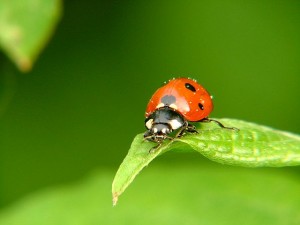Good bugs, bad bugs – take time to figure out which ones you should keep around
Posted on August 18th, 2012 by Andy

Photo by jpockele via Creative Commons License.
They’re squishy. They’re slimy. They have weird spiky things coming out of their heads. Bugs are unsightly creatures, and creepy to boot. But many of them are fairly benign in the vegetable garden; some such as ladybugs, damsel bugs and lacewings are beneficial. The good bugs eat the bad bugs that chew holes through your plants, so take time to figure out which ones you can keep around. The Southwest Community Land Trust has an excellent Bug Book that describes both good and bad bugs, has photographs of the damage they can do to plants and details how you can encourage the good ones and discourage the bad ones. The book also offers recipes for natural homemade sprays (garlic and chili pepper, for example) that can be used as an alternative to insecticides.
The Bug Book lists quite a few good bugs, including lady beetles (or ladybugs), praying mantids, soldier beetles, lacewings and damsel bugs. To attract these beneficial bugs, add nectar- or pollen-producing plants to your garden: daisies, dill, marigold, fennel, calendula, alfalfa, sunflowers, parsley, lemon balm, anise, zinnia, angelica, yarrow and coriander.
According to the Bug Book, here are a few bad bugs and what to do about them in your garden:
Aphids suck the juices off leaves, and sometimes spread plant diseases. As adults, they’re pear-shaped. Solution: control by spraying aphids off plants with a stream of water from the garden hose. Also plant dill, nasturtiums or calendula to attract aphids to those plants and away from other plants.
Cabbage loopers love to chew holes in lettuce, cabbage, celery, collard greens and tomato plants. They’re most damaging in the larvae stage, as green caterpillars. Solution: hand pick the bugs off the underside of leaves and throw them away; use row covers to prevent adult cabbage loopers from laying eggs on your plants.
Cucumber beetles as adults are very damaging to squash, melons, eggplants, tomatoes and peas. The adults are striped or spotted, and are yellow with black stripes or spots down its back. Solution: Hand pick the bugs off plants, spray with a garlic and pepper spray mixture; remove all weeds and plants from the garden at the end of season.
For more information (and photos) of good and bad bugs, here’s another good detailed guide.
Filed under:Seattle Landscape Maintenance, Vegetable Gardening | Permalink |



